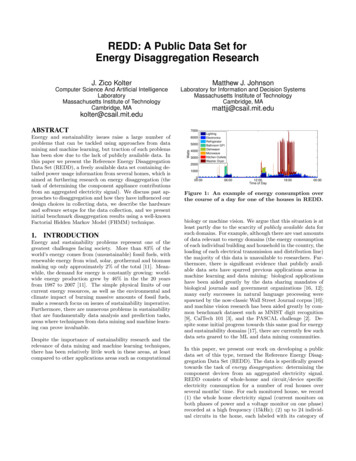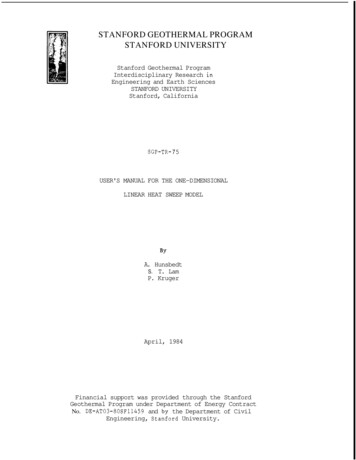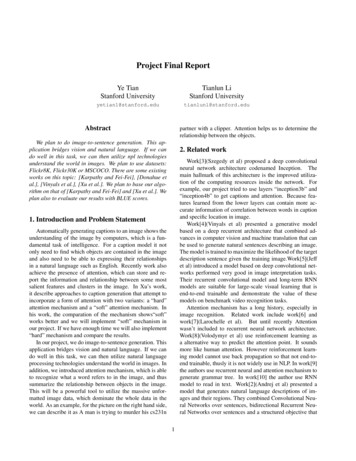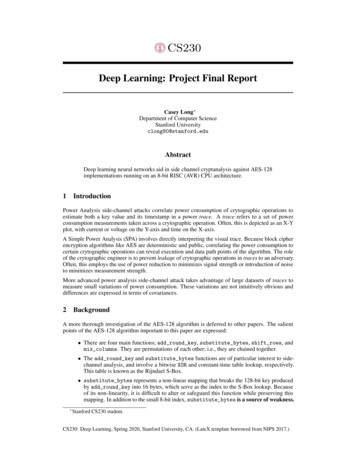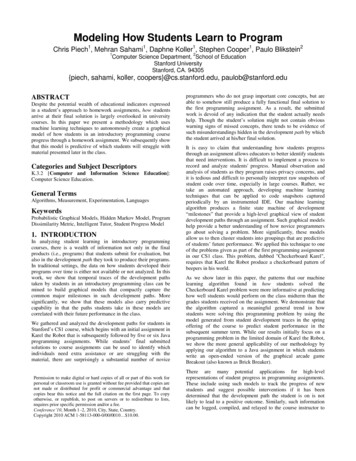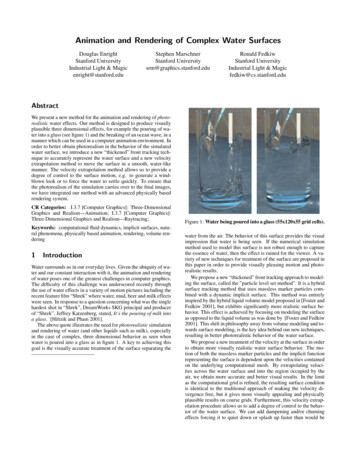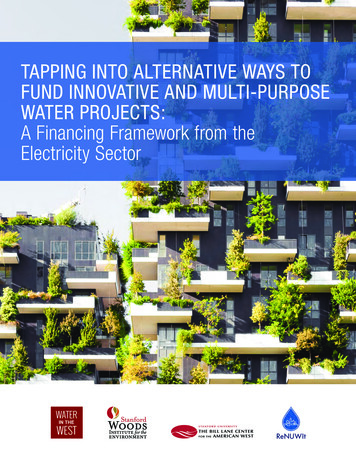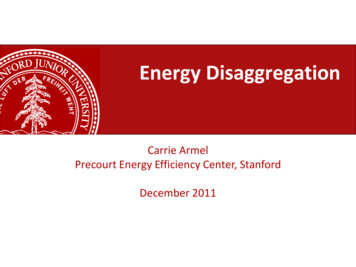
Transcription
Energy DisaggregationCarrie ArmelPrecourt Energy Efficiency Center, StanfordDecember 2011
What is Disaggregation?Disaggregation allows us to take a whole building (aggregate)energy signal, and separate it into appliance specific data (i.e.,plug or end use data). A set of statistical approaches are appliedto accomplish this.
Overview1.2.3.4.Why is appliance specific data useful?Disaggregation algorithm requirementsSmart meters constraintsRecommendations for using the algorithmswith smart meters
Appliance-Specific FeedbackEnhancedBillingHouseholdadvice4%Feedback TypeEstimated FeedbackWeb-based energy auditswith info on ongoing basis7%Daily/Weekly FeedbackHousehold-specific info, adviseon daily or weekly basis8%Real-Time FeedbackReal-time premise level info9%Real-Time Plus Appliance FeedbackReal-time info down to the appliance level12%Appliance Feedback, AugmentedDiagnostics, reccommendations, channeling to programs, and select automationEnergy Savings PotentialAnnual Energy Savings?%20% (Top 4 bars from Ehrhardt-Martinez,Donnelly, & Laitner, 2010)
Appliance Feedback AugmentedEngagement ChannelsOnline SocialNetworking.Improve Programs &Targeted MarketingCommunityProgramsOnline Recommendation SystemPersonalized diagnosticsAction ChannelsGuidedIndividualActionRetrofit ProgramsAppliance Programs.Change in Energy DataTransform ProgramEvaluation
Benefits of Appliance-SpecificEnergy Use DataDomainExplanationResidential EnergyReductions40 studies on feedback reducing energy use, with limited appliance-specificwork showing greater energy reductionsProvides clear recommendations and detection of malfunctions; householdscan then be channeled into specific programs (e.g., audits, appliancereplacements)Enables new behavioral approachesProgramEvaluationImproved sensitivity to detect change from programs, and iterativelyimprove programs.TargetedMarketingStrategic, specific, energy efficiency segmentation & marketingEconomic Modelsand Policy RecsEconomic models can be improved through specificity to better informpolicies, such as funding allocationsCommercialEnergy ReductionsLarge untapped savingsBuilding Researchand DesignEnd use specific information could clarify why predicted (i.e., modeled) andactual building energy use are discrepant, to guide future improvements.
Hardware Options forGetting Appliance-Specific nsingTechnologyPlug Level HardwareMonitors (e.g., Kill-A-Watt, EnergyHub)Smart AppliancesHouse Level CurrentSensor(example - TED,Blueline, Egauge etc.)Smart MeterCost toConsumerInstallationEffortAdoption 30- 50/plug; 300-600/homeMost plugs – Med240V plugs - HardLow; in existence forpast 7-8 years 100 additionalcompared to nonSmart appliancesEasy10-15 years afterintroduction for massadoption 200 /houseVery HardLow(high cost high effort)NoneNoneVery High & fast(installed by utilities)Smart Meter is the lowest-cost &lowest installation effort sensor for consumers
Disaggregation AlgorithmData Requirements1 hr –15 min1 min – 1 sec 10Hz – 2KHzSimilar toadjacent graphs 1MHzKHz SamplingMHz SamplingCurrent (Amps)DataAppearance 1 min SamplingPower (kW)1 hr PG&E10KHz –15KHzPower (kW)DataSamplingFrequencyCycle PortionData TypeUsed byAlgorithmsAppliancesIdentifiedVisually observablepatterns; durationand time of use ifconsistentGeneral categoriesof base load &variable load, andlow accuracy ofsome large peakloads like ACSteady statesteps/transitionsTop 10 appliancetypes - Refrigerator,ACs, Heaters, PoolPump, Washers,Dryers etc.Low orderharmonicsMedium orderharmonics toidentify type ofelectrical circuitryin applianceVery high orderharmonics toidentify bothtransients & thebackground noiseby appliancesNot Known, Fewstudies, perhapsbecause hardwarecost same at 10KHz20-40 appliancetypes – toasters,computers, etc.along with largerloads identified by1min-1secalgorithms40-100 specificappliances – e.g.,differentiates 2lights; requiresseparate powerconsumptiondata stream
Smart MeterHardware Capabilities1hr –15 min1min-1sec10Hz2KHz10KHzMHz (needs (needsAA/DConverter BMetrologyProcessor ProcessorDependentCMemories May supportDSerialInterface May beBorderline EComm.Processor ProcessorDependentFWANComm. firmwareupgrade) GHANComm. (needsDisaggregation Outside nly inside MeterFirmware OnlyHardware
Hardware Options forRunning the dUp to a few KHzNone for 1min.Enhanced HANfor a few KHz 1MHz (pluglevel voltagesampling)Plug Hardwarerequired forsamplingRun in theCloud onthird partyserversUp to a few KHzNone for 1min1sec;Enhanced HANfor a few KHz3Run in theMeterUp to a few KHz;Hardware changerequired for 1015KHz samplingUpgrade A/Dand Processor;Cost: 6- 10In Meter ASP4Run in UtilityBack Office1min gBee11WiFiAMI/WAN42UtilityBack-OfficeRun on aDevice In ely in the short termPossible in long termLess likely
Recommendations
Research Improve disaggregation algorithmsTo improve robustness and accuracy of the algorithms, while reducingfrequency, processing, and training requirements. Priorities are: 1min-1sec,10Hz-2KHz, 10-15KHz Develop a common data setThat captures variability over appliances as well as operating conditions andmake it available to developers – currently, a dearth of data is limiting dev’t Organize a competition using this data setAs with prior algorithms, this would foster algorithm development at universities Establish definitions of accuracyTo enable comparison of algorithms, and answer critical questions Establish testing facilities for evaluating algorithms in realisticenvironmentsDetermine real algorithm & smart meter capabilities by probing variouscomponents etc. Collaboration between universities and industry is useful here
Smart MetersLeverage Existing Smart Meters Upgrade firmware to make reactive power available in addition to activeThis allows algorithms to disaggregate more devices Upgrade firmware to support compression of dataTransmitting events/transitions instead of raw load profiles could significantly improve thefrequency of data available to HAN devices, as band-with is currently a bottleneckRevise Future Smart Meter Specs Support up to 15KHz of sampling frequencyCosts a few dollars and enables the next class of disaggregation algorithms Explore using low-power WiFi instead of ZigBeeEnables consumers to receive data from the Smart Meters without purchasing additionalhardware Support disaggregation inside the Smart MetersTo avoid AMI or HAN network being the bottleneck in transmitting data out of Smart Meter Add a serial port on meter to allow consumer owned device to directlyaccess their load profileAlready being done in Europe to maximize the potential of energy savings for consumers
Policy Mandate enabling of ZigBee radios soon, at least in pilotsHAN activation & data would accelerate the development of disaggregationalgorithms Mandate that Utilities share the data collected during HAN Pilotsanonymously with research institutesLack of real life data has been one of roadblocks for algorithm developers Mandate that Utilities select HAN devices that allow consumers toaccess or share their data with any third partyFosters innovation since small businesses can now sell directly to consumers andinvest time into developing superior disaggregation solutions Approve a rebate to make ZigBee gateways effectively free toconsumersNo different from a 100 rebate available for an Energy Star refrigerator – disaggregationcan provide much higher savings than a refrigerator alone
Commercial Solutions1.2.3.4.High Energy AuditsMyEnerSave, PlotWattDesert Research Institute, NavetasGE, Intel, Belkin
CollaboratorsAbhay Gupta, MyEnerSaveAdrian Albert, StanfordGireesh Shrimali, CSLIZico Kolter, MITkcarmel@stanford.edu
The Benefits1. Provide automated diagnostics/personalized recs2. Motivate action with specialized behavioral techniques Novel incentives & rate structures, Feedback, Markets,Competitions, Data visualization3. Create the best programs with speed, ease, cost, and scale4. Transform evaluation by incentivizing utilities &encouraging diversification of behavioral programs5. Improve segmentation for energy efficient marketing6. Improve building, and also appliance, research and design7. Inform policy with improved economic models We believe these benefits will be significantly augmentedwith “Appliance-Specific” (or End-Use) Data
RecommendationsLeveraging Existing Smart Meters1.2.3.4.Mandate enabling of the HAN soon, at least for pilotsDevelop firmware upgrades to provide reactive power to HAN devicesEncourage HAN devices that allow consumers to access or share their datawith any reputable third party, and provide rebates to make these freeFoster algorithm development to determine whether 10s-1min can givesufficient appliance recognitionShaping Future Smart Meters1.Explore using WiFi instead of ZigBeeEnables consumers to get data from Smart Meters without purchasing additional hardware2.Support up to 15KHz of sampling frequencyCosts a few dollars and enables the next class of disaggregation algorithms3.Support disaggregation inside the Smart MetersTo avoid AMI or HAN network to be the bottleneck in transmitting data out of Smart Meter
ResearchResearch Develop a common data setthat captures variability over appliances as well as operating conditions andmake it available to researchers Support algorithm developmentWith test facilities, evaluations, collaboration between industry anduniversities. Organize a competitionas has been done previously with algorithm development, as this would utilizethe dataset and foster algorithm development at universities and beyond. Establish definitions of accuracyto enable comparison of algorithms, and to assess the usefulness of highersampling frequencies.
The Benefits1. Provide automated diagnostics/personalized recs2. Motivate action with specialized behavioral techniques Novel incentives & rate structures, Feedback, Markets,Competitions, Data visualization3. Create the best programs with speed, ease, cost, and scale4. Transform evaluation by incentivizing utilities &encouraging diversification of behavioral programs5. Improve segmentation for energy efficient marketing6. Improve building, and also appliance, research and design7. Inform policy with improved economic models We believe these benefits will be significantly augmentedwith “Appliance-Specific” (or End-Use) Data
Marketing . Strategic, specific, energy efficiency segmentation & marketing : Economic Models and Policy Recs . Economic models can be improved through specificity to better inform policies, such as funding allocations : Commercial Energy Reductions . Large untapped savings : Building Research and Design
